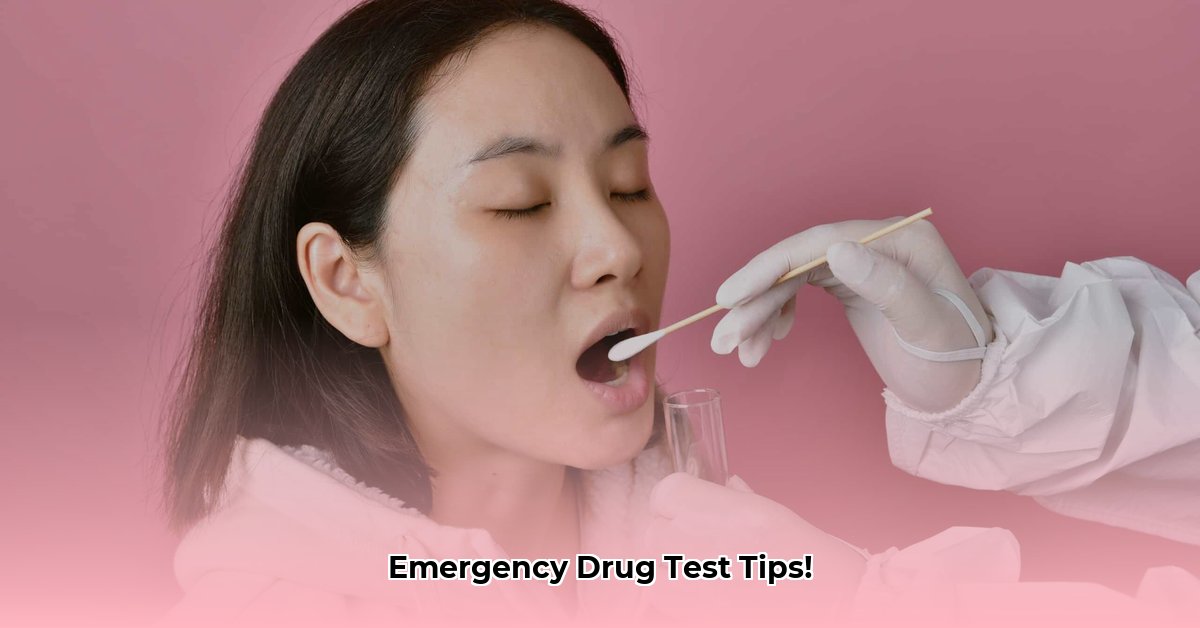So, you’re facing an oral swab drug test, possibly even today. The pressure is on, and you’re searching for solutions. This guide provides clear, factual information about oral swab tests, debunks common myths, and explores potential strategies. It’s crucial to understand that while some methods might slightly influence results, abstinence remains the most reliable approach.
Understanding the Oral Fluid Drug Test
Oral swab tests (also called saliva or mouth swab tests) detect drug metabolites in saliva, offering a snapshot of recent drug use, typically within the past few days. They’re designed to identify various substances, including marijuana, cocaine, amphetamines, opiates, and PCP. The detection window varies depending on factors like the specific drug, individual metabolism, frequency of use, dosage, and even potential genetic variations. Ongoing research continues to explore these factors.
Debunking the “Quick Fix” Myth
While the internet offers numerous “guaranteed” solutions, many lack scientific backing and may even be harmful. Let’s address some common misconceptions:
-
Myth: Brushing, rinsing, or using mouthwash eliminates drug metabolites. Reality: While good oral hygiene is always recommended, it’s unlikely to significantly impact test results. These methods might offer a very slight chance of temporarily reducing the concentration of metabolites, but they won’t erase evidence of recent drug use. Some mouthwashes contain alcohol, potentially triggering false positives for alcohol on certain tests. Specialized “detox” mouthwashes often contain masking agents that testing facilities can detect, leading to an invalid result.
-
Myth: Sour candies, gum, or excessive hydration flush your system. Reality: Stimulating saliva production or increasing water intake might offer minimal dilution, but it’s unlikely to drastically alter the test outcome. It’s more wishful thinking than a scientifically sound strategy. While hydration is essential for overall health, its impact on oral fluid drug test results is likely minimal.
-
Myth: Hydrogen peroxide cleanses saliva. Reality: Highly discouraged. Hydrogen peroxide is considered an adulterant, easily detectable, and poses serious health risks. It can cause oral and throat irritation, and ingestion can lead to severe health problems. Avoid this method entirely.
-
Myth: Fatty foods mask THC. Reality: While THC is fat-soluble, the amount absorbed by food before a test is negligible compared to existing levels from prior use.
-
Myth: Detox products guarantee a negative result. Reality: Many detox products lack rigorous scientific testing for oral fluid tests. Some might support overall detoxification, but their effectiveness in rapidly eliminating drug traces from saliva is questionable. They may also have potential side effects. Proceed with extreme caution and be aware there’s no guarantee they’ll work.
Strategies to Potentially Improve Your Chances
While abstinence is the most reliable approach, some strategies might slightly influence test results. It’s crucial to manage expectations and understand these are not foolproof solutions.
Limited Time Options (Minutes Before Test)
- Sour Candies/Gum: Stimulating saliva might offer minimal dilution, but its impact is likely negligible, especially with recent drug use.
- Mouthwash/Rinsing: (Use with caution): Might offer a very slight chance of temporarily masking metabolites but could raise suspicion or trigger false positives for alcohol. Some labs might flag certain mouthwashes as adulterants.
More Time Options (Hours Before Test)
- Frequent Water Rinsing: Similar to the theory behind hydration for urine tests, frequent rinsing might slightly flush out some metabolites. However, its effectiveness is uncertain.
- Detox Drinks (specifically for oral tests): While the market offers detox drinks, their effectiveness for oral swab tests is generally questionable and lacks substantial scientific evidence.
The Most Effective Approach: Abstinence
Abstinence for at least 72 hours before the test is the most reliable way to ensure a negative result. This allows your body time to naturally eliminate drug metabolites. The required timeframe varies based on factors like the specific drug, individual metabolism, frequency and amount of use.
Summary Table: Weighing Your Options
| Method | Likely Effectiveness | Potential Risks/Downsides | Time Investment |
|---|---|---|---|
| Abstinence (72+ hours) | Very High (Most Reliable) | None | 72+ hours |
| Frequent Water Rinsing | Possibly Slightly Effective | Minimal, potential discomfort | Several hours |
| Sour Candies/Gum | Possibly Slightly Effective | Minimal, sugar intake | Minutes |
| Hydrogen Peroxide/Mouthwash | Possibly Slightly Effective, Risky | Adulterant detection, health risks | Minutes |
| Detox Drinks (for oral) | Unproven | Unknown Side Effects, Cost, Unlikely to Work Quickly | Varies |
| Specialized Mouthwash | Possibly Slightly Effective, Risky | Potential Irritation, Detection, Invalid Result | Minutes |
Legal and Ethical Considerations
Attempting to manipulate a drug test using adulterants or other deceptive methods can have legal and ethical ramifications. Depending on the specific circumstances and regulations, it could lead to disciplinary action, legal consequences, or damage to your reputation. Making responsible choices is crucial.
Seeking Support
If you’re struggling with substance use, remember that help is available. Reaching out for support is a sign of strength, and there are resources dedicated to assisting individuals on their journey to recovery. Don’t hesitate to seek professional guidance. Resources like the Harm Reduction Coalition and the National Harm Reduction Coalition provide valuable information and support.
This information is for educational purposes only and does not constitute medical or legal advice. Consult with a qualified professional for personalized guidance. Remember, knowledge is power, and making informed decisions based on facts, rather than myths, is essential for your well-being.
- Shop Bento Lunch Boxes on Sale Nearby Now - December 7, 2025
- Shop Bento Box for Sale To Find Your Ideal Lunch Container - December 6, 2025
- Lunch Box That Fits Bento Box Neatly for Daily Use - December 5, 2025










